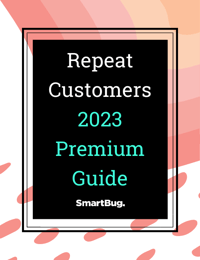
Repeat customer rate, also known as customer retention rate, refers to the percentage of customers who make a purchase from a business more than once over a given time period.
Because repeat customers tend to be more valuable than one-time customers, repeat customer rate is an important metric for e-commerce businesses. Repeat customers are more likely to make larger purchases, refer other customers, and provide valuable feedback that can help improve the business.
A high repeat customer rate can also help to increase the overall lifetime value of a customer because they are more likely to continue making purchases from the business over a longer period of time.
Why is repeat customer rate important for an e-commerce business?
Repeat customers are important to e-commerce businesses for a number of reasons:
1. Repeat customers are valuable.
Repeat customers tend to be more valuable to businesses than one-time customers because they are more likely to make larger purchases and have a higher lifetime value. This can help to increase the overall profitability of the business.
2. Repeat customers provide valuable feedback.
Repeat customers are more likely to provide valuable feedback about your products and services, which can help you to improve and refine your offerings.
3. Repeat customers drive word-of-mouth marketing.
Repeat customers are more likely to refer other customers to your business, which can help to drive new business and increase your customer base.
4. Repeat customers help to reduce marketing costs.
Acquiring new customers can be expensive because doing so requires investment in marketing and sales efforts. By retaining existing customers, you can reduce your marketing costs and focus on building relationships with those who are already familiar with your brand.
How do you calculate repeat customer rate?
To calculate repeat customer rate, you will need to determine the number of customers who made a second purchase within a given time period and divide that number by the total number of customers you had over the same time period.
Here's the formula:
Repeat customer rate = Number of customers who made a second purchase / Total number of customers
For example, let's say a business had 100 customers in the past year, and 50 of them made a second purchase within that time period. The repeat customer rate would be 50 percent, calculated as follows:
Repeat customer rate = 50 / 100 = 50 percent
It's important to note that the time period you choose to calculate repeat customer rate will depend on your business and your goals. You may want to calculate it over a shorter period, such as a month or a quarter, to get a more immediate picture of your customer retention rate. You may also want to look at a longer time frame, such as a year or several years, to get a more comprehensive view.
What is a good repeat customer rate?
There is no "one-size-fits-all" answer to what constitutes a good repeat customer rate for e-commerce; it will depend on a number of factors such as the nature of your business, the type of products you sell, and your target audience. However, as a general rule:
- A repeat customer rate of 20-40 percent is considered good for most businesses.
- A rate above 50 percent is excellent.
It's important to note that the average repeat customer rate for e-commerce businesses is around 20-30 percent. This means that if your repeat customer rate falls within this range, you are performing about average compared to other e-commerce businesses. However, every business is different, and it's important to set your own benchmarks and goals based on your unique circumstances.
How do you improve your repeat customer rate?
To improve your repeat customer rate, consider implementing strategies such as:
- Rewarding repeat customers with discount codes or free gifts.
- Focusing on customer service to go above and beyond to meet customers’ needs.
- Offering incentives to repeat customers such as bonus upgrades, additional samples, loyalty points, or store credit.
- Acting on customer feedback to show that you’re listening to your customers, you care about them, and you’re a customer-first company.
- Staying top of mind with email marketing, which is a top-performing communication tool.
- Reviewing customer data to better understand your customer’s shopping behavior and their likes and dislikes to inform your practices and update your marketing strategies.
- Building customer experiences by offering a one-of-a-kind service, a seamless checkout experience, and a personalized shopping experience.
By focusing on building long-term relationships with your customers, you can increase your repeat customer rate and drive more repeat business for your e-commerce business.
How does repeat customer rate vary by industry?
The repeat customer rate for e-commerce businesses can vary widely by industry because different industries have different customer demographics, buying patterns, and product life cycles. For example:
- Businesses that sell consumable products, such as food or beauty products, may have a higher repeat customer rate because customers are more likely to make regular purchases to restock these items.
- In contrast, businesses such as furniture or electronics stores may have a lower repeat customer rate because customers are less likely to make repeat purchases in these categories.
Here are a few examples of how repeat customer rate may vary by industry in e-commerce:
Fashion
Fashion e-commerce businesses may have a relatively low repeat customer rate because fashion trends and styles change rapidly and customers are less likely to make repeat purchases of the same products.
Beauty
Beauty e-commerce businesses may have a higher repeat customer rate because customers are more likely to make regular purchases of consumable items, such as makeup, skincare, and haircare products.
Home Goods
Home goods e-commerce businesses may have a moderate repeat customer rate because customers are likely to make occasional purchases of items such as furniture, home decor, and appliances, but they may not make repeat purchases as frequently as they would with consumable products.
Electronics
Electronics e-commerce businesses may have a relatively low repeat customer rate because customers are less likely to make repeat purchases of electronic devices and may instead upgrade to newer models when their current devices reach the end of their lifespan.
What other metrics should be measured?
In addition to repeat customer rate, several other important metrics and key performance indicators (KPIs) should be measured to understand the health and performance of a business. Here are a few examples:
Conversion Rate
Conversion rate refers to the percentage of visitors to your website who make a purchase. A high conversion rate indicates that your website is effective at converting visitors into customers.
Average Order Value
Average order value (AOV) refers to the average amount of money spent per order. A higher AOV can indicate that customers are buying more expensive products or are making larger purchases.
Customer Lifetime Value
Customer lifetime value (CLV) refers to the total amount of money a customer is expected to spend on your products or services over the course of their relationship with your business. CLV can be a useful metric for understanding the long-term value of a customer and helping to prioritize marketing efforts.
Customer Acquisition Cost
Customer acquisition cost (CAC) refers to the amount of money it costs to acquire a new customer. This includes marketing and sales expenses, as well as the cost of providing customer service. A lower CAC can indicate that your business is efficient at acquiring new customers.
Bounce Rate
Bounce rate refers to the percentage of visitors who leave your website after only viewing a single page. A high bounce rate can indicate that your website is not effectively engaging visitors and may need to be optimized.
Retain more customers with SmartBug Media.
Your marketing efforts should be focused on delighting customers while driving revenue. Partnering with SmartBug's e-commerce team of strategists and creatives, you get email and SMS marketing that isn’t just entertaining but also converts, turning those one-time shoppers into long-term customers.
Learn more about keeping your customers coming back by reading Repeat Customers: How to Get E-Commerce Customers to Swipe Right on Your Business.

About the author
Ryan O’Connor was formerly SmartBug’s Director of E-commerce Growth, product manager, and sales director. He enjoys helping readers learn how to solve big business challenges through consumer psychology within the constantly evolving e-commerce landscape. Over the past 10 years, Ryan has helped 1000s of DTC brands navigate challenges to grow fast through intelligent marketing. He’s not afraid to get his hands dirty, having launched his own e-commerce stores from the ground up. Read more articles by Ryan O’Connor.









